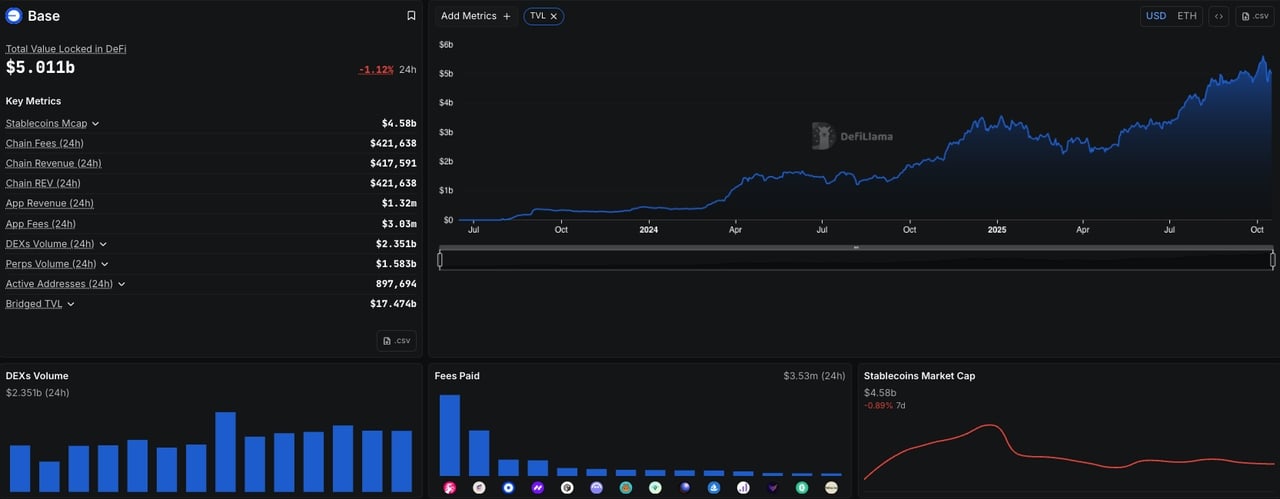Base, the Ethereum Layer-2 has shifted from “no token planned” to openly exploring a network token. The debate now focuses on what it could unlock, such as governance, liquidity incentives, and tighter interoperability.
As of mid-October 2025, there is still no native token and there will be no launch in 2025, as Brian Armstrong, the CEO of Coinbase, said. Meanwhile, the Base ecosystem is gaining momentum with the launch of a
Solana bridge on the testnet, new funding for builders, and growing interest in the “everything app”. The network is gaining strong traction, with total value locked (TVL) reaching around $14.6 billion on 16 October, and usage spreading across payments, trading, and creator tools.
This article outlines how Base works, explains why discussions about tokens have resurfaced, explores the proposals shaping the potential design and considers the utilities that a token might offer. It also highlights the key risks to be aware of.
What Is Base Layer-2 Network and How Does It Work?
Base, developed by Coinbase, is an
Ethereum Layer-2 network designed to solve Ethereum’s scalability problem. Using optimistic rollups batches transactions off-chain before posting them to Ethereum for final security. This reduces costs and increases speed while keeping the network fully compatible with the
Ethereum Virtual Machine. Recent wins include sub-second, sub-cent transactions and an open-source
Base to Solana bridge on testnet to move ERC-20 and SPL assets and deepen liquidity.
Essentially, Base operates as a fast lane alongside Ethereum’s main highway, offering faster and cheaper transactions. Supporting decentralised finance (
DeFi),
NFTs, gaming and other DApps, it aligns with Coinbase’s broader push to make Web3 more accessible to developers and everyday users.
Multiple reports rank Base as one of the largest blockchains by TVL. On 16 October, the network showed strong activity, with 755,000 active addresses and more than $17 billion in bridged assets over 24 hours.
Competition remains strong, with other Layer-2s like
Arbitrum and
Polygon targeting similar goals. Still, Base’s combination of scalability, developer tools, and institutional backing gives it a strong foothold. While the project continues to work toward greater decentralization and regulatory alignment, its growth signals that Coinbase’s “bridge, not island” approach is taking hold and helping to bring the next wave of users and developers onto Ethereum. Read more:
What Is the Base App and How to Set Up a Base Wallet?What Could the BASE Token Do? Possible Use Cases and Utilities
If Base proceeds with a token, credible models from OP Stack chains and
statements from Base leadership point to several practical roles. Below are well-supported possibilities you can expect if Base adopts patterns already used across the Superchain and L2 ecosystems:
1. Staking for a Decentralized Sequencer
If Base adopts a shared or decentralized sequencer, holders could
stake BASE Token to help secure ordering and earn rewards, with governance selecting or rotating operators.
2. Revenue Share Routed to the Base Ecosystem
Sequencer and network revenues on OP Stack chains are commonly funneled back into the ecosystem via programs like Optimism’s Retro Funding. A BASE token could mirror this model so holders govern how value accrues to builders and users.
3. ve-Style Locking and Liquidity Incentives
On Base, Aerodrome already uses vote-escrow mechanics where lockers direct emissions to specific pools. A BASE token could integrate similar ve-style incentives, turning governance power into boosted
yield and deeper liquidity in BASE-quoted pairs.
4. High-Impact Governance Over Incentives and Upgrades
Holders could vote on emissions, incentive targets, and upgrade preferences, aligning with Superchain governance patterns that steer funding and public goods. This protects value capture and prioritizes programs that grow usage.
5. Interoperability and Growth Rewards
Base announced an open-source bridge to Solana on testnet. A token could reward cross-chain liquidity, bridging, and integrations that expand real usage across
ERC-20 and SPL assets.
6. Clear Alignment with Base’s Publicly Stated Roadmap
Leadership confirmed they are exploring a network token while building in the open and remaining Ethereum-aligned. A token can formalize incentives for builders and users under that philosophy, creating durable demand for locked supply.
When Is the Base (BASE) Token Expected to Launch?
Community chatter ranges from “about to be launched” headlines to direct statements from Jesse Pollak that there will be no token launch in 2025. Leadership frames the effort as early-stage exploration with no specifics yet on design, governance, or timing. In short, you should treat 2025 as off the table and view the current phase as open research and community input.
Debate around a potential BASE token is heating up. Messari researcher
AJC says any distribution should balance user rewards with COIN shareholder interests, since a public company exploring its own cryptocurrency faces unique constraints.
Some voices even float a Base spin-off to surface value outside Coinbase’s reporting. Others push back on rewarding social activity and want incentives tied to real impact and builders. Caution also extends to exchange listings, with some urging selective venues to avoid repeats of past L2 missteps. Adding signal, Vitalik Buterin has praised Base’s progress on decentralization, a notable endorsement as design talks continue.
How to Prepare for a Possible BASE Token Launch or Airdrop
Although Base has not announced official tokenomics and leadership says there will be no launch in 2025, you can still take practical steps to position yourself for a potential airdrop or early user programs if a token is introduced later. Here is a simple, step-by-step guide to help you prepare safely and effectively.
Before Base Launches a Token
1. Start using Base now: Explore apps on Base with small, manageable transactions to understand fees, bridges, and common workflows. Early participation does not guarantee rewards, but a consistent activity record often matters in community programs.
2. Build real usage patterns: Interact with reputable
DeFi, NFTs, and social apps on Base. Provide liquidity or test products that are core to daily activity rather than only chasing one-off campaigns.
3. Follow official channels only: Keep an eye on announcements from Base and Coinbase leadership for any updates about token exploration, snapshots, or eligibility rules. Avoid relying on rumors or unverified posts.
4. Beware of scams: Treat any “BASE claim portal” with caution. Double-check URLs, signer prompts, and contract addresses before connecting a wallet or signing transactions.
5. Understand tokenomics basics: Learn total supply, vesting, unlock schedules, and emissions. Knowing how these work will help you make better decisions if a token goes live.
At Token Launch or Listing
1. Verify everything: Confirm the official token contract address against Base’s primary announcements. Look for code audits or security reviews before interacting.
2. Check for airdrop eligibility: If you have been active on Base, watch closely for claim windows tied to potential on-chain snapshots. Missing a window can mean losing possible rewards.
3. Monitor unlock schedules: Team or investor allocations may unlock after listing, which can create sell pressure. Tracking these dates helps you plan entries and exits more strategically.
What Are the Key Risks to Watch Ahead of a $BASE Token Launch?
Design and allocation will make or break it. Proposals float a 20% strategic reserve for Coinbase and 20% for validator incentives, which means emissions and alignment must be tuned carefully to avoid bad incentives or heavy unlock overhangs.
Operational risk is real. On August 5 a failed sequencer handover halted block production for 33 minutes, disrupting deposits, withdrawals, and trading. On distribution, the community warns against rewarding surface-level activity and wants incentives aimed at builders and protocols that create lasting liquidity and usage.
Regulation is a swing factor. Even with a friendlier read on the U.S. landscape, compliance stays central and Base keeps stressing work with regulators and lawmakers. Market structure is another hurdle. L2 tokens have struggled to capture value versus ETH, and while ideas like quote-currency demand and adaptive emissions aim to change that, execution risk remains.
Final Thoughts
For now, leadership is clear: no launch in 2025, early-stage research, and an open, Ethereum-anchored approach. Read the signals with patience and focus on what is actually shipping, such as interoperable infrastructure, builder funding, and app-layer traction, as design debates play out.
Related Reading

